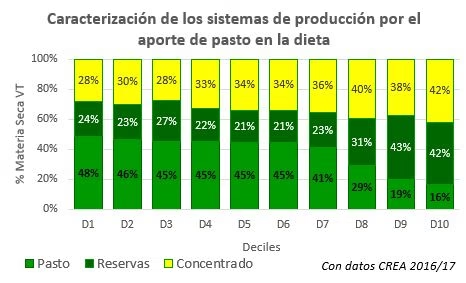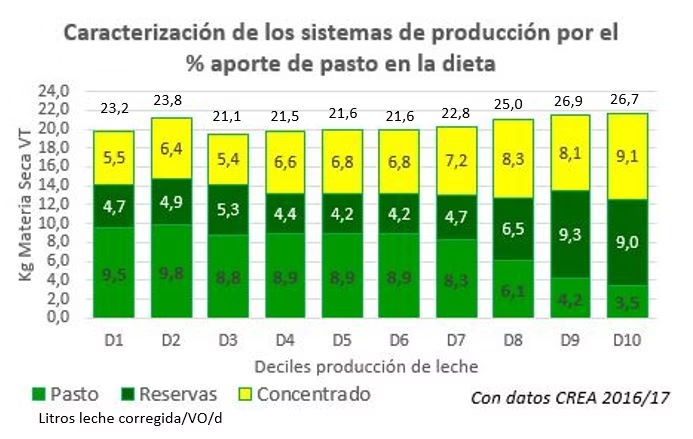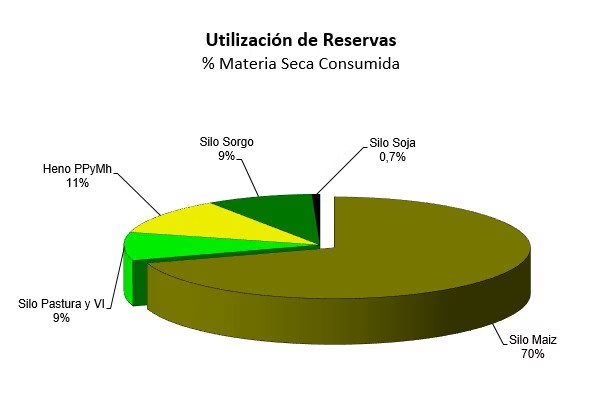Production systems

The production of commercial milk arises from a decision of an entrepreneur to combine the resources and supplies available in the most convenient way to achieve more economic rent. This possibility of combining resources and inputs is limited by the quality of soils and the climatic characteristics of the environment where the activity is carried out. Argentina is a “hybrid” country with the possibility of grazing throughout the year, as New Zealand, and has agricultural soils as the united States. Also, and as we see in the map with the geographic location of the drums, about half of them are located in the central strip (-32° to -30° south latitude) with high exposure to heat stress. In this central basin strategy to give comfort to the cows, in this area of high ITH, passed by the stalling (mostly Dutch), or with the adoption of varied crosses.

Making a stratification of the drums of CREA, empresas que producen el 10% de la leche del país y repartidos en todas las cuencas lecheras argentinas, observamos que en todos los deciles el uso del pasto esta presente en alguna medida. En el gráfico que acompaña, observamos los distintos sistemas de alimentación implementados (se ordenó la base de datos por nivel de aporte del pasto en la dieta y luego agrupó por deciles). Los tambos con encierre total están incluidos en D9 y D10 con uso de pastoreo 0%, representan alrededor del 6% de la muestra.
Figure 1, with details of the participation of foods on total diet in each decile and figure 2 with the kg of dry matter/cow and production in LCG by cow milking.


The main sources of reserves in the sample:


frames... great contribution to this site.... a query in argentina there is an area where propere the production system based essentially on pastures... with low use of concentrates?... type NZ?
slds.
Argentina has better land, but not with the weather NZ. For this reason perhaps, the producer will increase the load with pasture production and reserves foragers carried out with annual crops, which when combined, allow you to manage volumes equal to or greater dry matter/ha.
It is not necessarily a "zone", the producers differ at the time of taking decisions in their enterprises and some seek to maximize the production by providing a greater amount of concentrates by example and others minimize the expenses by restricting the consumption of concentrated working on the marginal value of production.
The percentage of liters produced in Argentina produces the silo of corn?
Hi Alvaro
The silage of corn by itself is out of balance for the production of milk, which has a good level of energy, but very low % protein (a test average in dry basis of silage would be 7-8% of PB, while the average diet of a dairy cow requires 15-16% of PB of the total dry matter intake). Anyway adding protein can correct this imbalance, either via high quality pastures, or any protein source as the seed of cotton, pellet of sunflower, pellets, soybean, etc
In Argentina, the silage maize is the most widely used remedy for reservations of winter, and we estimate that approximately 85% of the producers spend between 10 to 15% of the surface of the exploitation of their culture.
The first impression of the fourth model is that it is missing individual production for some reason, to a question of power like that. It should be at a minimum of 27 litres and 20,000 litres / ha VT.
Excellent article as always!!!!
I agree Jorge, that the planets intensive (circle, etc.) may incur a higher cost of power and should get better productions. Let us remember that they are not models but quartiles generated after the administration of the database by use of grass in the diet. What I have observed in particular cases for that exercise CREATES is that the impact of heavy rainfall made him change the individual production of many plans to enclose that have not invested in the comfort of the cow...the clay makes havoc!
Mark, I congratulate you both for the analysis of the data to Air as the clarity of the responses, demonstrating that there are so many costs and models such as drums and that means that while some lose money, others to win. What if it is very clear that the models intensive is shred it when it disappears, the comfort animal is needed to exceed 30 liters/cow/day stably.
If Roberto, that % of dairy farms that have embarked on the path of the circle need to move more than the rest on issues of comfort -many schema type drylot in areas llovedoras - which in turn requires access to capital at reasonable rates to produce...
"Hello Mark
in livestock breeding areas with reserves of sorghum and meadows of fescue the tone is low, supplementing concentrates and emphasize loaded with productions that for many are poor because they do not exceed 25 litres per cow.
In contrast, in agricultural fields with reserves of corn and alfalfa, and point to high production per cow..with all forages of excellent quality, very well managed.
This idea is not for family businesses. It is for companies organized where the actions of all the days it does EVERYTHING WELL. In the family enterprise, this condition is dificilisima. The family-run business with tambo in the field agricola, close the drum and makes agriculture.."
Alberto Lesser (via mail)